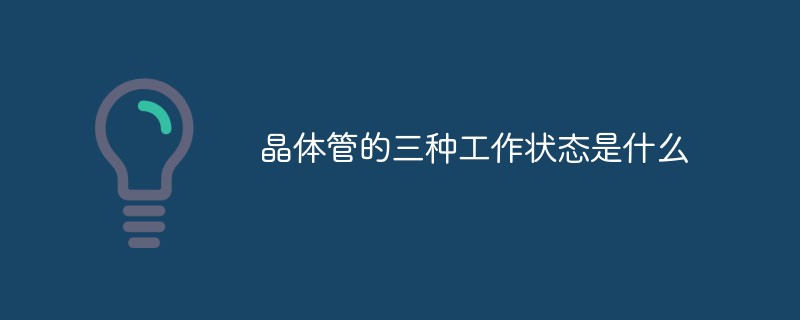What are the three working states of a transistor?
The three working states of a transistor are: 1. Off state. When the voltage applied to the emitter junction of the transistor is less than the conduction voltage of the PN junction, the collector and emitter are equivalent to the off state of the switch. . 2. Amplification state, when the voltage applied to the emitter junction of the transistor is greater than the conduction voltage of the PN junction, and when the base current increases to a certain extent; 3. Saturation conduction state.

The operating environment of this tutorial: Windows 7 system, Dell G3 computer.
Transistor (transistor) is a solid semiconductor device (including diodes, transistors, field effect transistors, thyristors, etc., sometimes specifically referred to as bipolar devices), which has the functions of detection, rectification, amplification, switching, voltage stabilization, Signal modulation and other functions. The transistor acts as a variable current switch that controls the output current based on the input voltage. Unlike ordinary mechanical switches (such as relays and switches), transistors use electrical signals to control their own opening and closing, so the switching speed can be very fast, and the switching speed in the laboratory can reach more than 100GHz.
Three working states of the transistor:
Cut-off state: When the voltage applied to the emitter junction of the transistor is less than the conduction voltage of the PN junction, the base current is zero , the collector current and the emitter current are both zero, and the triode loses its current amplification function at this time. The connection between the collector and the emitter is equivalent to the disconnected state of the switch. We say that the triode is in the cut-off state.
Amplification state: When the voltage applied to the emitter junction of the triode is greater than the conduction voltage of the PN junction and is at a certain appropriate value, the emitter junction of the triode is forward biased and the collector junction is reverse biased. , at this time, the base current controls the collector current, so that the transistor has a current amplification effect, and its current amplification factor β=ΔIc/ΔIb. At this time, the transistor is in an amplified state.
Saturated conduction state: When the voltage applied to the emitter junction of the transistor is greater than the conduction voltage of the PN junction, and when the base current increases to a certain extent, the collector current no longer follows the base current. It increases with the increase, but does not change much near a certain value. At this time, the triode loses the current amplification function, the voltage between the collector and the emitter is very small, and the connection between the collector and the emitter is equivalent to the conduction of the switch. state. This state of the transistor is called the saturated conduction state.
According to the potential of each electrode of the triode when it is working, the working status of the triode can be judged. Therefore, during the maintenance process, electronic maintenance personnel often use a multi-meter to measure the voltage of each pin of the triode to determine the status of the triode. Work situation and work status.
For more related knowledge, please visit the FAQ column!
The above is the detailed content of What are the three working states of a transistor?. For more information, please follow other related articles on the PHP Chinese website!

Hot AI Tools

Undresser.AI Undress
AI-powered app for creating realistic nude photos

AI Clothes Remover
Online AI tool for removing clothes from photos.

Undress AI Tool
Undress images for free

Clothoff.io
AI clothes remover

AI Hentai Generator
Generate AI Hentai for free.

Hot Article

Hot Tools

Notepad++7.3.1
Easy-to-use and free code editor

SublimeText3 Chinese version
Chinese version, very easy to use

Zend Studio 13.0.1
Powerful PHP integrated development environment

Dreamweaver CS6
Visual web development tools

SublimeText3 Mac version
God-level code editing software (SublimeText3)

Hot Topics
 1378
1378
 52
52


